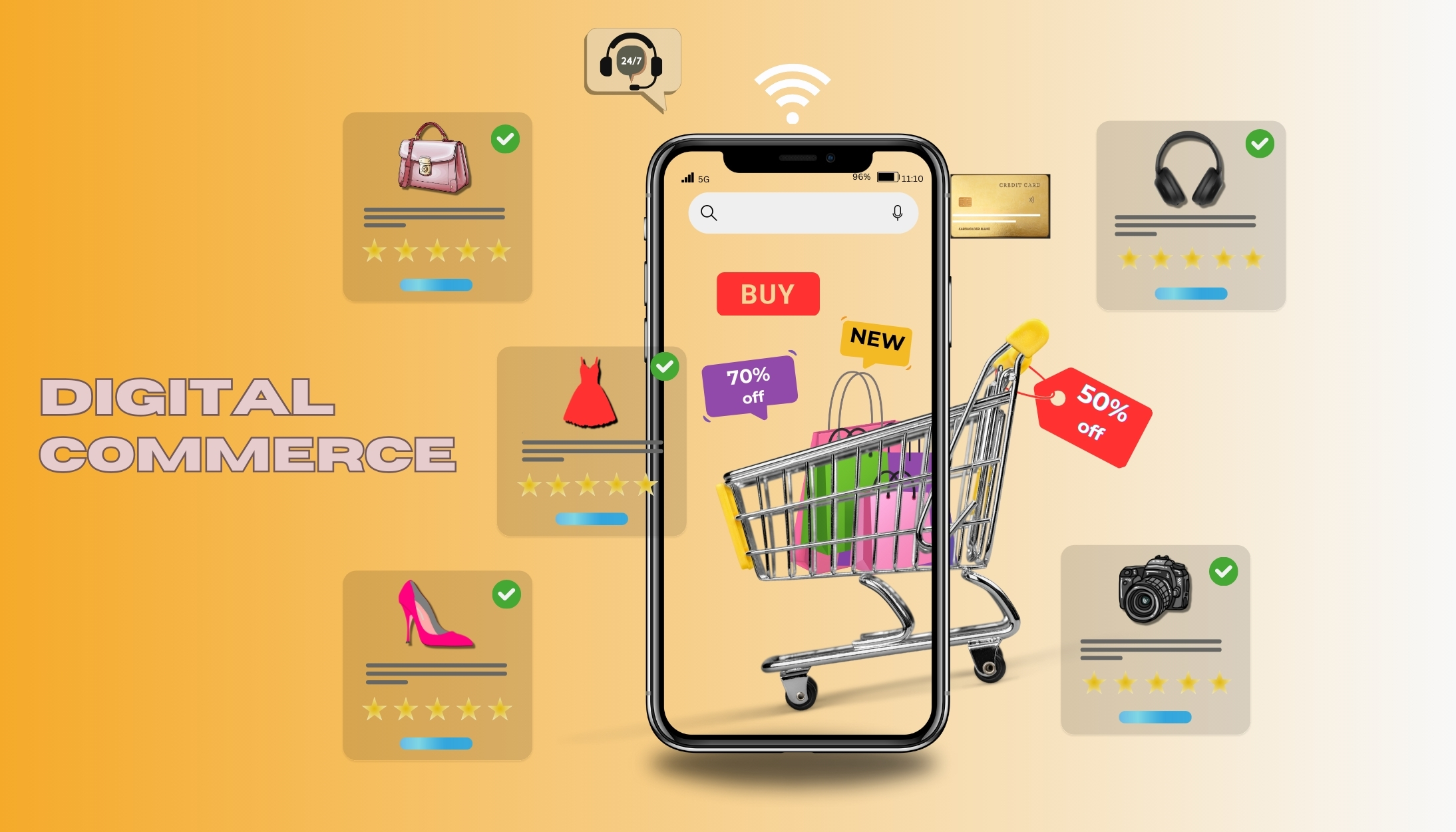Table of Contents
Digital Commerce: Revolutionizing Business in the Digital Era
In today’s fast-paced world, where technology is constantly evolving and consumer habits are shifting, digital commerce has become a game-changer for businesses worldwide. At its core, digital commerce is all about buying and selling goods and services online, using digital platforms and tools to make transactions smoother than ever before.
In essence, digital commerce isn’t just a trend; it’s a fundamental shift in the way we do business. By embracing the opportunities it offers, businesses can reach new heights of success, connecting with customers in ways that were once unimaginable.
Getting to Know Digital Commerce
Digital commerce goes beyond mere online transactions; it’s about curating unforgettable experiences for customers. Think of it as bringing the warmth and personal touch of a traditional brick-and-mortar store to the digital realm. Every interaction, from browsing products to completing a purchase, should feel like a personalized journey tailored to the individual customer.
In the world of retail, digital commerce isn’t just a passing fad; it’s the future. It’s about more than just facilitating transactions; it’s about forging genuine connections with customers. Whether through user-friendly mobile apps, engaging social media platforms, or intuitive websites, the goal is to create meaningful interactions that resonate with customers on a deeper level.
The Evolution of Digital Commerce: A Closer Look at Today’s Online Shopping Experience
From its beginnings as a novel concept, digital commerce has rapidly transformed into a vital part of our daily lives. Today, it’s all about connection—between businesses and consumers—enhanced by ever-evolving technology.
- Mobile and Personalized Shopping: Mobile devices now dominate the online shopping landscape, with over 72% of e-commerce sales made through mobile platforms as of 2023. This shift to mobile isn’t just about accessibility; it’s about personalization. Artificial intelligence helps businesses offer a shopping experience uniquely tailored to each user, suggesting products based on past behaviors and preferences.
- Sophisticated Advertising: As digital commerce grows, so does the sophistication of online advertising. Targeted ads are now the norm, powered by detailed analytics that allow businesses to reach consumers with precision, thus making every marketing dollar count.
- Emerging Shopping Avenues: Social media platforms have turned into shopping avenues, blending browsing and buying into one seamless experience. Meanwhile, augmented reality is changing how we shop by letting us ‘try’ products virtually, enhancing confidence in purchase decisions and reducing returns.
- Global Reach and Sustainability: Online shopping has erased geographical boundaries, allowing consumers to shop globally. This accessibility comes with a growing consumer preference for sustainable products, pushing businesses to adopt eco-friendly practices.
In essence, digital commerce today is not just about buying and selling but creating a shopping experience that feels personal, seamless, and responsible. As technology continues to advance, so will the ways we connect, shop, and explore products from around the world.
The Heart of Digital Commerce: Elevating Customer Experience
Customer experience is the linchpin of digital commerce. Whether it’s a cozy corner store online or a sprawling multinational e-commerce site, the key to thriving in this competitive space is the same: put your customers first. Satisfied customers become loyal advocates, and loyalty is the cornerstone of sustained success.
- Personal Touches Make a Big Impact: In digital commerce, personalization isn’t just an added bonus; it’s crucial. By harnessing the power of data analytics and AI, businesses can deliver a shopping experience that feels tailored to each individual. Imagine logging onto a website that remembers your past preferences and suggests products accordingly—this level of personalization can transform a routine purchase into a delightful experience.
- Consistency Across All Channels: Today’s customers might browse your products on mobile in the morning, skim through your emails at lunch, and finalize purchases on a laptop in the evening. A seamless and consistent experience across all these platforms is key. When businesses manage to synchronize their message and service across every channel, customers notice—and appreciate—the coherence.
- Speed and Convenience are King: In our fast-paced world, convenience rules. A digital storefront that loads slowly, has a complicated navigation, or makes checking out a chore is likely to drive customers away. On the flip side, a smooth, fast, and intuitive shopping experience is a surefire way to win hearts. Features like one-click buying and speedy delivery are not just conveniences; they are necessities.
- Responsive Customer Service: There’s nothing more frustrating than needing help and not being able to get it. A robust customer service framework is essential. Whether it’s through a quick chat function, responsive social media, or a well-maintained helpdesk, effective support can turn potential frustrations into solutions, and irritated customers into loyal fans.
- Keep the Conversation Going: Feedback isn’t just noise; it’s gold. By actively seeking and responding to customer feedback, businesses don’t just fine-tune their operations—they also show they value their customers’ opinions. This ongoing dialogue fosters a sense of community and belonging among customers.
- Engage and Educate: Why not make every interaction with your brand a chance to learn? Blogs, how-to videos, and interactive guides can do more than just inform—they can entertain and engage. When customers find value beyond just the products, they’re more likely to stick around.
- Trust is Everything: In the digital age, security isn’t an option; it’s a prerequisite. Transparency about how data is used, coupled with strong security measures, builds trust. Customers need to feel confident that their personal information is safe and respected.
By focusing on these elements, businesses not only attract new customers but also build a loyal customer base that is less inclined to switch to competitors. This customer-first approach is truly the heart of modern digital commerce
The Future of Digital Commerce: A Glimpse into Tomorrow’s Shopping
The future of digital commerce promises an exciting blend of innovation and convenience, reshaping how we interact with our favorite brands. Visionaries at Magneto IT Solutions forecast a world where emerging technologies like augmented reality (AR) and voice commerce become everyday tools in our shopping arsenal.
- Augmented Reality: Imagine trying on a pair of sunglasses or checking how a new sofa fits in your living room without leaving your house. Augmented reality is set to make this a reality, offering a virtual try-before-you-buy experience that adds a new layer of convenience and confidence to online shopping.
- Voice Commerce: On the other hand, voice commerce simplifies shopping to the point of conversation. Just by speaking to your virtual assistant—be it Alexa, Siri, or Google Assistant—you could reorder your daily essentials, from shampoo to coffee. This hands-free shopping isn’t just convenient; it’s a game-changer for multitaskers and those with mobility challenges.
- Seamless Integration: As these technologies mature, we’ll see them seamlessly integrate into our daily lives, making online shopping as natural as speaking or seeing. The potential extends beyond mere convenience; it’s about creating a personalized shopping experience that feels magical.
- Endless Possibilities: The integration of AR and voice technology in digital commerce is just the beginning. As we look to the future, the possibilities for innovation are limitless. Each advancement brings us closer to a world where digital shopping experiences are as rich and interactive as physical ones, if not more.
In essence, the future of digital commerce is geared towards making shopping not just a task but an enjoyable and integrated part of our daily lives. With each technological leap, we move closer to a world where our digital and physical realities blend seamlessly, making our interactions with products and brands more engaging, intuitive, and—most importantly—personal.
Digital Commerce vs. E-commerce: Understanding the Difference
You might have heard both “digital commerce” and “e-commerce” being used, and you might be wondering if they mean the same thing. While they’re closely related, there’s a slight difference.
E-commerce is a broader term that refers to any type of commercial transaction conducted electronically, including online retail stores, online marketplaces, and online auctions.
On the other hand, digital commerce encompasses not only buying and selling goods online but also includes digital downloads, online subscriptions, and digital services.
E-Commerce Growth
Global retail e-commerce sales are expected to reach approximately $7.4 trillion by 2025, up from $4.9 trillion in 2021, demonstrating a significant growth trajectory in online shopping.
- Mobile Commerce: As of 2023, over 72% of e-commerce is expected to be generated via mobile devices. This shift underscores the importance of mobile-optimized websites and apps in the digital commerce strategy
- AI in Retail: By 2025, it’s estimated that 70% of retailers will utilize some form of artificial intelligence technology for customer engagement, inventory management, and personalized recommendations, enhancing the overall shopping experience.
- Social Commerce: Social commerce sales in the United States are projected to exceed $80 billion by 2025, indicating a robust integration of e-commerce capabilities directly within social media platforms.
- Cross-Border E-Commerce: Cross-border e-commerce accounted for 22% of global e-commerce shipments in 2020. This trend allows consumers to purchase products from different countries more easily, promoting a more interconnected market.
- Consumer Preferences for Digital Experiences: A survey found that 49% of consumers shop more online now than pre-COVID-19, with many indicating a preference for digital channels due to convenience and safety.
- Impact of Reviews and Personalization: Approximately 87% of consumers read online reviews for local businesses in 2020, highlighting the importance of customer feedback in purchasing decisions. Personalization can increase sales by up to 20% as it significantly enhances the shopping experience by tailoring offers and products to individual preferences.
- Sustainability Concerns: Increasingly, digital commerce is being leveraged to address sustainability, with options like green logistics and eco-friendly packaging. Approximately 68% of online consumers in Europe prefer to buy products with minimal environmental impact, indicating a shift towards more sustainable consumer habits.
10 Best Digital Commerce Platforms
- FatherShops: Fathershops distinguishes itself with a flexible theme builder for unique brand expression and its own integrated payment gateway, ensuring secure and streamlined transactions. This makes FatherShops a top choice for businesses looking to scale and enhance their e-commerce presence effectively.
- Shopify: A favorite among businesses of all sizes, Shopify shines with its extensive app ecosystem, enabling users to extend functionality and tailor their stores to specific needs.
- WooCommerce: Perfect for WordPress enthusiasts, WooCommerce provides powerful tools for building a highly customizable online store, seamlessly integrating with your existing WordPress site.
- BigCommerce: Known for robust out-of-the-box features, BigCommerce is ideal for businesses looking to scale efficiently. Its comprehensive set of tools supports complex operations without the need for extensive customizations.
- Magento (Adobe Commerce): Catering to large enterprises, Magento offers unparalleled flexibility and control over the user experience, with advanced features that support complex business models and global expansion.
- Salesforce Commerce Cloud: Best suited for large operations requiring a reliable cloud-based platform, Salesforce Commerce Cloud delivers a rich set of features geared towards enhancing customer engagement and streamlining operations.
- Wix: Wix is all about user-friendliness and design freedom, offering a drag-and-drop interface that makes website building accessible for everyone, backed by a suite of powerful tools for enhancing functionality.
- Squarespace: Renowned for its stunning templates and intuitive design capabilities, Squarespace is a great choice for creatives looking to build visually appealing sites with minimal effort.
- PrestaShop: This platform is a cost-effective choice for small to medium-sized businesses, offering comprehensive functionality with strong community support for an easy start and sustained growth.
- Volusion: Focused on providing a seamless all-in-one e-commerce solution, Volusion integrates strong analytics tools, helping businesses track performance and make data-driven decisions.
In Conclusion
Digital commerce isn’t just a trend; it’s a revolution that’s here to stay. By prioritizing customer experience, embracing new technologies, and understanding the nuances of the digital landscape, businesses can unlock endless opportunities for growth and success.
So, what are you waiting for? Dive into the world of digital commerce and watch your business soar to new heights!
FAQs
1.What do you mean by digital commerce?
Digital commerce refers to the buying and selling of goods and services through digital channels. It encompasses a variety of online marketplaces, from traditional e-commerce websites to mobile apps and social media platforms, using technology to facilitate commercial transactions.
2.What are the uses of digital commerce?
Digital commerce is used for increasing accessibility to goods and services, reaching a broader audience, reducing operational costs, improving customer service through automation, and gathering data on customer preferences and behaviors for better business strategies.
3.What are the examples of digital commerce?
Examples include online retail stores like Amazon, digital content providers like Netflix, services like Uber, and software sales platforms like the App Store or Google Play. Additionally, social media platforms now often integrate direct purchasing capabilities.
4.How does digital commerce benefit consumers?
Digital commerce offers convenience, wider selections, competitive pricing, and personalized shopping experiences based on consumer behavior and preferences.
5.What technologies are shaping the future of digital commerce?
Augmented reality (AR), artificial intelligence (AI), and blockchain technology are among the key innovations enhancing the security, interactivity, and personalization of digital commerce experiences.
6.What challenges does digital commerce face?
Issues include data privacy concerns, cybersecurity threats, intense competition, and the need for continuously evolving technology solutions to meet consumer expectations.



 Free dropshipping courses
Free dropshipping courses




